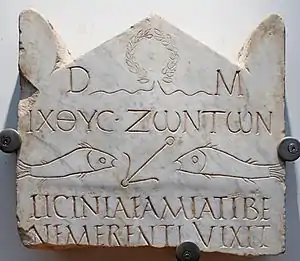Ichthys
The ichthys or ichthus (/ˈɪkθəs/[1]), from the Greek ikhthýs (ἰχθύς 1st cent. AD Koine Greek [ixˈθys], "fish") is a symbol consisting of two intersecting arcs, the ends of the right side extending beyond the meeting point so as to resemble the profile of a fish. The symbol was adopted by early Christians as a secret symbol. It is now known colloquially as the "sign of the fish" or the "Jesus fish".[2]

Origin

The first appearances of the ichthys symbol in Christian art and literature date to the 2nd century AD. The symbol's use among Christians had become popular by the late 2nd century, and its use spread widely in the 3rd and 4th centuries.[3] In the early Church, the ichthys symbol held "the most sacred significance", and Christians used it to recognize churches and other believers through this symbol because they were persecuted by the Roman Empire.[4] The ichthys symbol is also a reference to "the Holy Eucharist, with which the miracle of the multiplication of the loaves and fishes had such intimate connection both in point of time and significance."[5] While many Christians hang a cross necklace or rosary inside their vehicles, "the fish sticker on the car is a more conscious symbol of a witnessing Christian—significantly, unlike the former, it is on the outside of the car for everyone to see."[6]
Symbolic meaning
ἸΧΘΥΣ (ichthys), or also ἸΧΘΥϹ with a lunate sigma, is an backronym or acrostic[7] for "Ἰησοῦς Χριστὸς Θεοῦ Υἱὸς Σωτήρ", Iēsous Christos, Theou Yios, Sōtēr; contemporary Koine, which translates into English as 'Jesus Christ, Son of God, Savior'.
- Iota (i), Iēsous (Ἰησοῦς), "Jesus"
- Chi (ch), Christos (Χριστός), "anointed"
- Theta (th), Theou (Θεοῦ), "God's", the genitive singular of Θεóς, Theos, "God"
- Upsilon (y or u), (h)yios[8] (Yἱός), "Son"
- Sigma (s), sōtēr (Σωτήρ), "Savior"
This explanation is given among others by Augustine in his Civitate Dei,[9] where he notes that the generating sentence "Ἰησοῦς Χριστὸς Θεοῦ Υἱὸς Σωτήρ"[10] has 27 letters, i.e. 3 × 3 × 3, which in that age indicated power. (This suggestion is obviously spurious as the phrase has 26 letters, resulting from Augustine's ignorance of Greek.)[11] Augustine quotes also an ancient text from the Sibylline oracles[12] whose verses are an acrostic of the generating sentence.
The statement "Jesus Christ, Son of God, Savior" affirmed the belief of early Christians in the twofold nature, of Jesus Christ being both fully human and fully divine. The belief in Jesus Christ being true Man and true God completes the Most Holy Trinity, that is the basic article of the Christian faith.
A fourth century A.D. adaptation of ichthys as a wheel contains the letters ἸΧΘΥΣ superimposed such that the result resembles an eight-spoked wheel.[13]
Egon Friedell speculates in his Cultural History of Antiquity, that the symbol of the fish may refer to the astrological age of pisces, which started at around the time of the establishment of Christianity. Thus, the symbol may have been used to symbolise the starting of a new age.
In the Gospels
Fish are mentioned and given symbolic meaning several times in the Gospels. Several of Jesus' 12 Apostles were fishermen. He commissions them with the words "I will make you fishers of men". (Mark 1: 16-18)
Having been resurrected, Jesus offered some grilled fish in Luke 24:41-43.[14]
At the feeding of the five thousand, a boy is brought to Jesus with "five small loaves and two fish". The question is asked, "But what are they, among so many?" Jesus multiplies the loaves and fish to feed the multitude.
In Matthew 13:47-50, the Parable of Drawing in the Net, Jesus compares the angels separating the righteous from the wicked at the end of this world to fishers sorting out their catch, keeping the good fish and throwing the bad fish away.[15]
In John 21:11, it is related that the disciples fished all night but caught nothing.[16] Jesus instructed them to cast the nets on the other side of the boat, and they drew in 153 fish. When they return to shore with their catch, Jesus is waiting for them and has cooked some fish for them to eat.
In Matthew 17:24-27, upon being asked if his Teacher pays the temple (or two-drachma) tax, Simon Peter answers yes. Christ tells Peter to go to the water and cast a line, saying that a coin sufficient for both of them will be found in the fish's mouth. Peter does this and finds the coin.[17]
The fish is also used by Jesus to describe "the Sign of Jonah". (Matthew 12:38-45) This is symbolic of Jesus's resurrection, upon which the entire Christian faith is based. (1 Corinthians 15:1-58)

In the Book of Tobit
In the Deuterocanonical Book of Tobit, by Raphael the Archangel's order, the young cousin and future spouse of Sarah captures a fish while it tries to swallow his feet, washing in the river Tigris. Then he is instructed how to offer it, in order to be saved from the daemon Asmodeus.[18]
Early church
According to tradition, ancient Christians, during their persecution by the Roman Empire in the first few centuries after Christ, used the fish symbol to mark meeting places and tombs, or to distinguish friends from foes:
According to one ancient story, when a Christian met a stranger in the road, the Christian sometimes drew one arc of the simple fish outline in the dirt. If the stranger drew the other arc, both believers knew they were in good company. Current bumper-sticker and business-card uses of the fish hearken back to this practice.
— Christianity Today, Elesha Coffman, "Ask The Expert"[19]
There are several other hypotheses as to why the fish was chosen. Some sources indicate that the earliest literary references came from the recommendation of Clement of Alexandria to his readers (Paedagogus, III, xi) to engrave their seals with the dove or fish. However, it can be inferred from Roman monumental sources such as the Cappella Greca and the Sacrament Chapels of the catacomb of St. Callistus that the fish symbol was known to Christians much earlier.
In popular culture

In the 1970s the "Jesus Fish" started to be used as an icon of modern Christianity. In 1973 the symbol and message was taken to the Aquarius Rock Festival in Nimbin, Australia. Today, it can be seen as a decal or emblem on the rear of automobiles or as pendants or necklaces as a sign that the owner is a Christian. Versions of this include an Ichthys with "Jesus" or "ΙΧΘΥΣ" in the centre, or simply the Ichthys outline by itself.[20]
The Ichthus Music Festival is an annual large outdoor Christian music festival held in mid-June in Wilmore, Kentucky. It is the oldest Christian music festival in the United States, starting in 1970.[21]
In 2016, a Unicode glyph encoding on code point 1F9XX for the ichthys symbol was proposed.[22]
See also
References
- "ichthus". Oxford English Dictionary (third ed.). 2007.
- Los Angeles Times (1 April 2008). "Evolution of religious bigotry". latimes.com.
- Rasimus, T. (2011). "Revisiting the Ichthys: A Suggestion Concerning the Origins of Christological Fish Symbolism". Pp 327-348 in Mystery and Secrecy in the Nag Hammadi Collection and Other Ancient Literature: Ideas and Practices. Biblical Studies, Ancient Near East and Early Christianity E-Books Online, Collection 2012, 76.
- Jowett, Garth S.; O'Donnell, Victoria (11 March 2014). Propaganda & Persuasion. SAGE Publications. p. 86. ISBN 9781483323527.
Initially used as a secret sign during the time when Christians were persecuted by the Roman authorities, the fish symolized the mission of the group it represented and did so simply and effectively.
- The Irish Monthly, Volume 12. 1884. p. 89.
It must, however, be born in mind that the "fish," specially in those early days, was a Christian symbol of the most sacred significance. The name ichthus, which is the Greek word for fish, and the fish itself, recur frequently amongst the sacred symbols of the early Christians in the Catacombs. The letters of the Greek word formed the initial letters of the phrase "Jesus Christ, of God the Son, our Saviour" The heavenly Ichthus, then, was Jesus Christ, and we are the smaller fishes, born in the waters of baptism, as Tertullian says, caught in the net of salvation, and thus made members of the heavenly kingdom. There is a reference to the same symbol to the Holy Eucharist, with which the miracle of the multiplication of the loaves and fishes had such intimate connection both in point of time and significance.
- Garbowski, Christopher (27 January 2014). Religious Life in Poland: History, Diversity and Modern Issues. McFarland. p. 222. ISBN 9780786475896.
If folk religion is demonstrated by drivers with rosaries hanging from rearview mirrors or St. Christopher figures on the dashboard, still common enough in Poland, the fish sticker on the car is a more conscious symbol of a witnessing Christian--significantly, unlike the former, it is on the outside of the car for everyone to see. This stops some interested Catholics from placing the symbol on their cars. Since they feel might not live up to the good driving practices that should accompany its presence.
- Christian H. Bull, Liv Ingeborg Lied, John D. Turner, editors (2012). Mystery and Secrecy in the Nag Hammadi Collection and Other Ancient Literature: Ideas and Practices. Leiden, The Netherlands: Koninklijke Brill NV. p. 327. ISBN 978-90-04-21207-7.CS1 maint: multiple names: authors list (link)
- The initial "h" was sometimes pronounced, depending on dialect and period, but in Ionic orthography the "h" sound was written with the rough breathing diacritical mark attached to the upsilon, not with a full letter (Ὺιός), and so would not be used to form a backronym. By the Early Christian period, the aspirate was probably lost in most popular varieties of Greek.
- Augustine. . XVIII, 23 – via Wikisource.
- On the appropriate accent in Christos and Hyios, consult grave accent rule.
- Bagatti, Bellarmino (1984). The church from the circumcision: history and archaeology of the Judaeo-Christians. Studium Biblicum Franciscanum, Collectio Minor, n.2. Jerusalem. p. 215.
- Sibylline oracles, Book viii, 284-330 (Greek text, 217-250)
- Christian H. Bull, Liv Ingeborg Lied, John D. Turner, editors (2012). Mystery and Secrecy in the Nag Hammadi Collection and Other Ancient Literature: Ideas and Practices. Leiden, The Netherlands: Koninklijke Brill NV. pp. 340, 343. ISBN 978-90-04-21207-7.CS1 maint: multiple names: authors list (link)
- Luke 24:41-43
- Matthew 13:47-50
- John 21:11
- Matthew 17:24-27
- Tobit 6:1-9
- Elesha Coffman (August 8, 2008). "What is the origin of the Christian fish symbol?". christianitytoday.com.
- "Christian symbols: Fish (Ichthus), cross and crucifix". religioustolerance.org. Retrieved 22 April 2014.
The body of the symbol may be empty, or may contain a name ('Jesus' or 'ICTUS').
- See, Robison, Greg, Christian Rock Festivals, (New York: The Rosen Publishing Co., 2009), p.7
- West, Andrew (2016). "Proposal to encode an Ichthys symbol" (PDF). unicode.org. Retrieved 2020-04-12.
External links
| Wikimedia Commons has media related to Ichthys. |
| Look up ichthys in Wiktionary, the free dictionary. |
- Principal Christian Symbols: The Fish (Ichthus), Cross & Crucifix Extensive explanations on several popular Christian symbols, including the ichthys
- Symbolism of the Fish - Catholic Encyclopedia article
